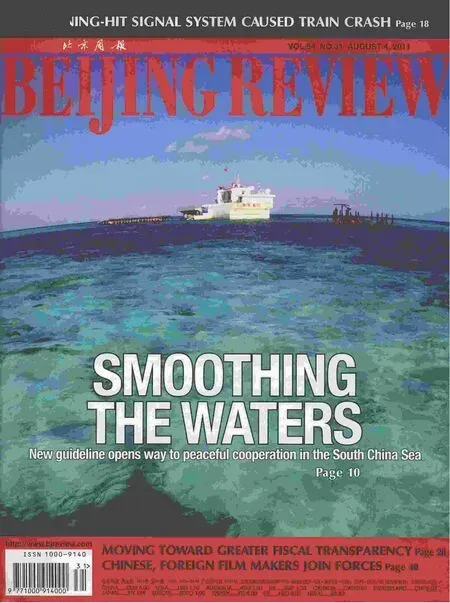Still Arguing
2011-12-24ByLIJINMING
By LI JINMING
Still Arguing
By LI JINMING
The origin and ongoing debate of the South China Sea issue
The South China Sea dispute centers on the sovereignty over the Nansha Islands, a network of islands that stretches 1,000 km from north to south in the southeastern corner of the sea. China was the first country to discover and name the islands. It was also the frst to exercise sovereignty over them and has maintained that sovereignty for hundreds of years.
The dispute did not erupt until the early 1970s, after a UN exploration in 1969 showed the South China Sea may be oneof the most oil-rich and natural gas-heavy regions in the world.
Two years later, a global oil crisis broke out. In 1973, the UN held a conference on the law of the sea, launching discussions that later led to the adoption of the UN Convention on the Law of the Sea. The convention defined a 200-nautical mile exclusive economic zone for each coastal state.
Triggered by these factors, Southeast Asian countries by the South China Sea started showing a strong interest in the Nansha Islands. Occupations of the islands by these countries, for various reasons, quickly commenced. Some of their arguments follow:
Viet Nam:Of the Southeast Asian countries neighboring the South China Sea, Viet Nam is the only one that claims sovereignty over all of the Nansha Islands. It bases these claims on the grounds that it has been in possession of the islands the longest in historical terms. Viet Nam frst renamed the Nansha Islands and the Xisha Islands to their north as “Truong Sa” and “Hoang Sa.” It then claimed its historical records about Truong Sa and Hoang Sa provided evidence the feudal state of Viet Nam was the frst to occupy and explore the islands in the South China Sea.
Rebuttal:A survey of Viet Nam’s historical documents, coupled with Chinese historical records, shows Truong Sa and Hoang Sa were located off the coast of central Viet Nam. They are completely different from China’s Nansha Islands and Xisha Islands.
From 1954 to 1975, the Vietnamese Government publicly recognized the Nansha Islands and the Xisha Islands as Chinese territories on a number of occasions. For instance, Vietnamese Prime Minister Pham Van Dong acknowledged these islands were Chinese territories in his diplomatic note to Chinese Premier Zhou Enlai on September 14, 1958. This was further confirmed by a world map published by the General Headquarters of the Vietnamese People’s Army in 1960. In the map, the Nansha Islands were marked as Chinese territory. Later in 1972, Viet Nam’s surveying and mapping authorities printed a map in which the Nansha Islands were marked in the Chinese language rather than in Vietnamese, English or French.
Viet Nam’s second case: Viet Nam also claimed it should inherit the Nansha Islands as the successor of Frenchcontrolled Vietnamese territory.
Rebuttal:France did not control the Nansha Islands after World War II. Moreover, there were no documents proving a transfer between France and Viet Nam. What’s more, Viet Nam acknowledged the Nansha Islands and the Xisha Islands as Chinese territories in the past. Therefore, based on the estoppel rule of the international law, the current Vietnamese Government should adhere to its previous acknowledgement.
Philippines:The Philippines claims sovereignty over part of the Nansha Islands. Its basis is a presidential decree, which stated the islands are crucial for the national security and economic development of the Philippines. The Philippines are nearest to these islands; and legally, these islands do not belong to any country, rather, they areterra nullius, it said.
Rebuttal: The Philippines cannot make a sovereign claim over islands for the sake of its own national security and economic interests, even if it really needs the oil and other natural resources there to sustain its economic activities.
It is unreasonable for a country to claim sovereignty over a territory because it is closest to that territory. Many nations have ownership over islands and territories that are separated by vast oceans. Some possess islands off their neighboring countries’ coasts. The ownership of these islands is never changed due to geographical proximity.
The Nansha Islands have long been Chinese territory. They are notterra nullius.
Malaysia and Brunei: Both Malaysia and Brunei claim sovereignty over part of the Nansha Islands with the reason that these islands and reefs are located on the continental shelf that they claim as their own.
Rebuttal:This argument is against the provisions of the international law and the UN Convention on the Law of the Sea. Based on these laws, coastal states’ rights over the continental shelf are to explore and develop the natural resources at its seabed and subsoil, rather than possess the islands and reefs located on it.
Also, a basic principle of the international maritime law is that land dominates the sea rather than the other way around. In other words, only when a country has sovereignty over the islands can it claim sovereignty over the ocean areas around the islands.
China has had sovereignty over the Nansha Islands since ancient times. Malaysia and Brunei have no reason whatsoever to extend their continental shelves to the territories of China, no matter how close these islands and reefs are to their coasts.
The author is a professor with the Research School of Southeast Asian Studies at Xiamen University
